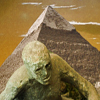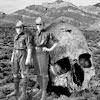The Curse Of The Presidents
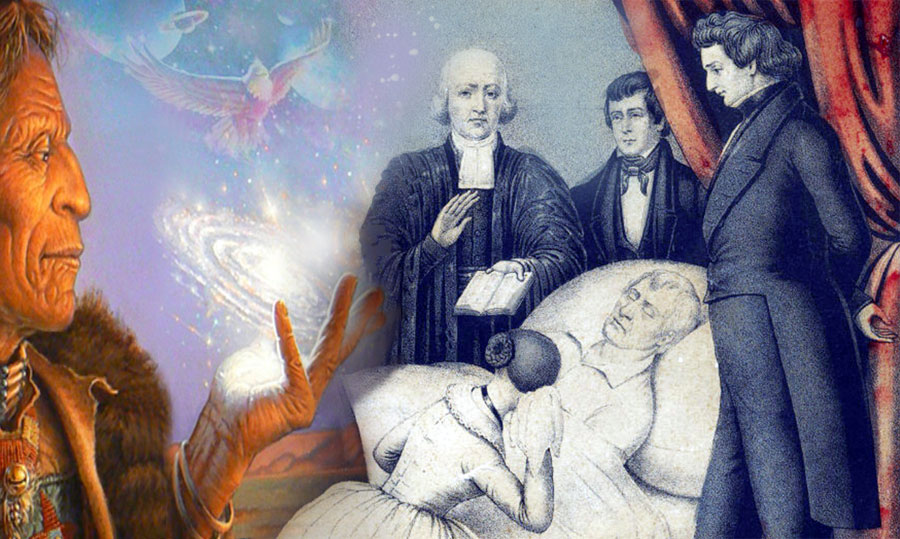 by Vincent H. Gaddis
by Vincent H. Gaddis
Once there was a prophet—Tens-Ka-Ta-Wah, or Elskatawa, meaning “The Open Door,” but called by the Americans simply “the Prophet.” He certainly deserved the title, for he 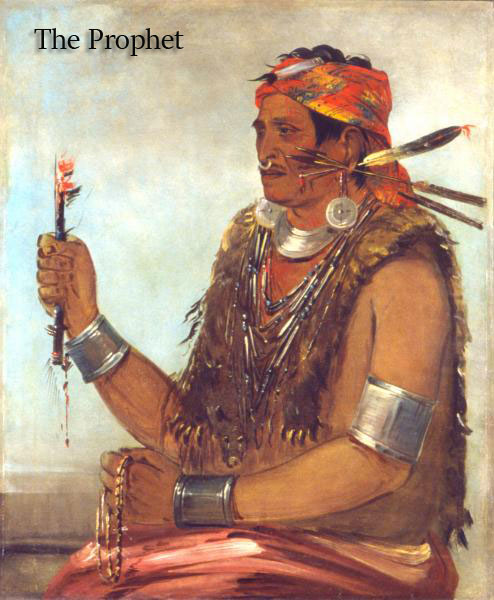 made one of the most amazing true prophecies in American history and left a grim legacy that still haunts the United States presidency. His brother was the great Tecumseh (Shooting Star), considered by many historians to embody the highest conception of Amerindian character.
made one of the most amazing true prophecies in American history and left a grim legacy that still haunts the United States presidency. His brother was the great Tecumseh (Shooting Star), considered by many historians to embody the highest conception of Amerindian character.
The remarkable crusade of the Shawnee brothers began with a dream. One night while living in a White River village in Indiana, Elskatawa fell asleep. When he awakened he was a man with a vision. He had made a visit to the realm of spirits, he told the villagers, and there he had been given a new religion that would save the red man.
A curious mixture of Amerind and Christian doctrines, the new faith’s basic tenets were a return to the simple life of their forefathers and the avoidance of everything connected with the white man’s civilization. Abstinence from liquor was advocated, as well as an end to all conflict between tribes. Speaking through the Prophet, the Great Spirit laid down the rules governing courtship, marriage, daily bathing and limitations on intercourse and trading with the whites. Inspired or not, it was at least a well-planned program of Amerind reform, and it spread rapidly through the woodland tribes.
Behind this revival was a 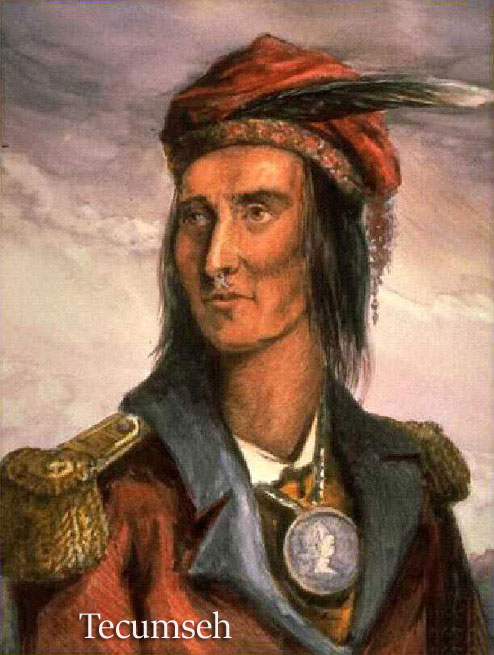 political menace. A relentless tide of settlers was coming from the east, and by 1808 a series of treaties made by General William Henry Harrison with widely scattered tribes had deprived the Amerind of most of the southern third of the present state of Indiana. The signing of the Treaty of Fort Wayne alone cost the native Americans three million acres between the Wabash and White Rivers.
political menace. A relentless tide of settlers was coming from the east, and by 1808 a series of treaties made by General William Henry Harrison with widely scattered tribes had deprived the Amerind of most of the southern third of the present state of Indiana. The signing of the Treaty of Fort Wayne alone cost the native Americans three million acres between the Wabash and White Rivers.
The Prophet was a man with great oratorical ability and apostolic fervor. His brother Tecumseh was a fearless, upright leader with a deep love for his troubled race. A brilliant statesman, Tecumseh realized the need for political unity among the tribes, and he attempted to make the land the common property of all. By stopping the piecemeal cession of lands, he hoped to stop the westward advance of the whites without bloodshed. His motto was simply “America for the Americans.”
Together, the Shawnee brothers labored to create the second great Indian confederacy. The Prophet’s faith served to fuse into emotional unity the peoples that his brother was attempting to lead with practical statesmanship. They tried, first, to get an agreement from the tribes not to sell any more land, but the chieftains were reluctant to surrender their traditional rights of making treaties. Nevertheless, some progress was made, and General Harrison, at his Indiana Territory headquarters at Vincennes, decided to act.
He sent a message to all the tribes: “Who is this pretended prophet who dares speak in the name of the Great Creator? If he is really a prophet, ask him to cause the sun to stand still—the moon to alter its course—the rivers to cease to flow—or the dead to arise from their graves.”
The Prophet accepted the challenge. He boldly announced that around noon on June 16, 1806, he would cause darkness to come over the sun as evidence of his supernatural powers. To the utter bewilderment of the tribes, his prophecy came true. It is possible, of course, that he had information from a white man who owned an almanac, but during that period he had little contact with whites and was spending much of his time in fasting and long periods of trance.
Meanwhile, Tecumseh was determined to hold the Ohio River as a dividing line between the races. He tirelessly visited tribes from Wisconsin to Florida, seeking support for his confederacy and an end to tribal treaties. “Sell the land!” he exclaimed. “Why not sell the air, the clouds, and the great sea . . . Did not the Great Spirit make them all for the use of all his children?”
In June 1808, the brothers and a large band of their followers, gathered from many tribes, moved to the west bank of the Wabash River, near the mouth of the Tippecanoe, and built Prophet’s Town. Intoxicants were prohibited. Crops were planted in the surrounding fields. The town grew rapidly as hundreds of warriors broke away from their stubborn chiefs. Tecumseh too had the help of the British, who hoped to establish an Indian buffer state to the rear of the American colonies. A steady stream of men and arms flowed between Fort Malden in Canada and Prophet’s Town.
During the winter of 1809-1810 feeling ran high as the situation grew more tense. For the most part the Miamis and Delawares remained peaceful, but the Kickapoo, Potawatomi, Winnebago and Wyandot tribes sent war parties to the Wabash where they joined the deserters from the peaceful nations. Turbulent mass meetings inspired by the Prophet’s oratory added to the state of angry unrest.
General Harrison became alarmed. He summoned Tecumseh to a grand council at Vincennes in August 1810, and Tecumseh came, still hoping to avert bloodshed. But the conference was futile. The two leaders could not agree on the problem of land sales. Tecumseh then proposed a truce while he visited the Creeks and other tribes in the south, after which he planned to see President James Madison in an effort to solve completely the difficulties existing between the two peoples.
Harrison’s opinion of Tecumseh is of interest:
The implicit obedience and respect which the followers of Tecumseh pay to him is really astonishing and more than any other circumstance bespeaks him one of those uncommon geniuses, while spring up occasionally to produce revolutions and overturn the established order of things. If it were not for the vicinity of the United States, he would, perhaps, be the founder of an empire that would rival in glory Mexico or Peru.
One of Tecumseh’s complaints at the grand council was that in the Treaty of Fort Wayne signed the year before, other tribes had disposed of lands to which the Shawnees had a claim. Harrison’s reply was that he would refer the question of ownership of the land to the President. “Well,” said Tecumseh, “as the Great Chief is to determine the matter, I hope the Great Spirit will put sense enough into his head to induce you to give up this land . . . he is so far off that he will not be injured by this war; he may sit in his town and drink his wine, whilst you and I will have to fight it out!”
It was in 1807—a year before the founding of Prophet’s Town– that an astonishing prophecy was included in a lengthy message sent to all the tribes by the Prophet. It can only be regarded as one of the most incredible previsions in history. And as R.E. Banta writes in his book The Ohio: “There is no question as to the authenticity of either the talk or the prophecy.” It was read by Le Maiquois—the Trout—a follower of the Prophet, to a gathering of Chippewas and other Lakes Indians at Michilimackinac on May 4, 1807, and was reported in full in a letter from Captain Dunham, commandant of that post, to General William Hull at Detroit in that same month.
The prophecy was as follows: “Now, therefore, my children, listen to my voice, it is that of the Great Spirit! ‘If you hearken to my counsel and follow my instructions for four years, then there will be two days of darkness, during which I shall tread unseen through the land and cause the animals, such as they were formerly when I created them, to come forth out of the earth . . .’” It was the Prophet’s plan to have this talk with its forecast of catastrophe circulated among the tribes “during the summer and fall of 1807—four years and a small varying fraction before December 1811.”
By the year 1811 the prophecy was being repeated by Tecumseh and had gotten down to actual dates. At the time of the Battle of Tippcanoe Tecumseh was in the south seeking the support of the Cherokees and the Creeks. While visiting the Creek Chief Big Warrior at Tuckhabatchee on the Tallapoosa River, in the late fall of that year, Tecumseh stated that a great earthquake would occur the day he returned to Detroit and the Creek villages would be destroyed.
Thomas L. McKenney, coauthor of the book History of the Indian Tribes of North America, obtained the account of this forecast from Big Warrior himself. The chief said that Tecumseh told him: “You have taken my talk and the sticks, and the wampum and the hatchet, but you do not mean to fight. I know the reason. You do not believe the Great Spirit has sent me. You shall know! I leave Tuckhabatchee directly, and I shall go to Detroit. When I arrive there, I will stamp on the ground with my foot, and shake down every house in Tuckhabatchee.”
Tecumseh had given strict orders to avoid conflict while he was in the south. There were widespread reports of war preparations at Prophet’s Town, however, and General Harrison received an order from President Madison to break up the rendezvous on the Wabash. With an army of about 900 men, Harrison came within sight of the town on the afternoon of November 6, 1811, and camped on a plateau about a mile away.
Following the lead of General Harrison’s account, most historians have blamed the Prophet for precipitating the battle. The story is that he assembled the warriors and brought out the magic bowl and the talismans, which he assured the braves would protect them from the soldier’s bullets. Then during the fighting, it is said, he stood on a high rock overlooking the battlefield uttering magical incantations. On the other hand, a settlement of Shakers then living near the town said that the Prophet and some of his followers abstained from the fighting, and that the battle was precipitated in spite of him.
The attack on Harrison’s camp came in the misty Hoosier dawn. A good part of the battle consisted of bitter, deadly hand-to-hand struggle. Soon after daylight Harrison managed to organize his forces for a series of charges, and the warriors were driven into a nearby swamp and scattered. His victory was a costly one—nearly a fourth of his men were killed or wounded. In comparison Amerindian casualties were small. On the following morning Harrison rode to Prophet’s Town, now deserted, and burned the village with all its supplies. Then, with his dead and wounded, he returned to Vincennes.
Days later, as Tecumseh was traveling north but still below the Ohio River, messengers told him of the disaster. For him, the work of a decade lay in ruins. Skirting the settlements, he made his way to Detroit. Meanwhile, the Prophet with a group of his faithful followers had reached Fort Malden, at the mouth of the Detroit River on the Ontario side, where they placed themselves under the protection of the British.
A few weeks after the battle a horde of squirrels, stirred by some mysterious impulse, pressed south from Indiana. They poured into the Ohio River, swimming, clinging to drifting bits of wood. Thousands of lifeless bodies drifted downstream, a mute warning of the terror to come.
Then, thirty-seven days after the Battle of Tippecanoe, at two o’clock on the morning of December 16, the earth moved. Amerindians and settlers were awakened by an ominous rumbling that slowly grew in intensity. They hurried from their dwellings into the night. A weird glow lit the sky as the ground swayed under their running feet. Dazed and bewildered, they huddled beneath trees as inanimate objects around them danced and groaned with a sudden life born of chaos.
Through the long night and the light of dawn, shock succeeded shock as the earth buckled and rocked. Centering around New Madrid, Missouri, the quakes were felt over a region of more than 300,000 square miles. A district of 30,000 square miles sank from five to twenty-five feet, while other areas were raised by similar amounts. Reelfoot Lake in Tennessee, eighteen miles long, was created. At several places the Mississippi and Ohio Rivers flowed backward, and the course of the Mississippi was changed for hundreds of miles. Several hundred lakes and islands were formed on a 300-mile front from the mouth of the Ohio to the St. Francis River. As the convulsions continued, some of these lakes, miles in extent, were formed or drained in less than an hour. Thousands of trees choked the river currents.
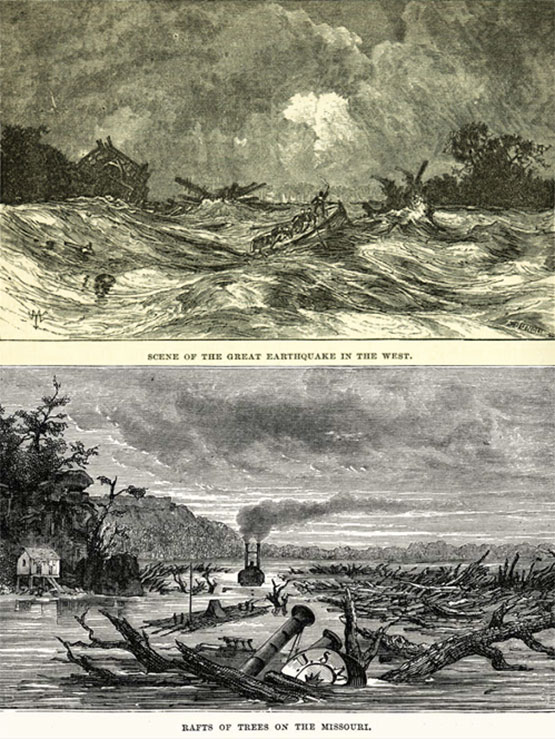 Rising and falling in sickening waves, the earth’s surface split into fissures, some half a mile long, and sulfurous gases poured out. Trees were bent until their branches interlocked into a leafy ceiling. Landslides swept furiously down bluffs and river banks, the entire cemetery at New Madrid being carried away into the river.
Rising and falling in sickening waves, the earth’s surface split into fissures, some half a mile long, and sulfurous gases poured out. Trees were bent until their branches interlocked into a leafy ceiling. Landslides swept furiously down bluffs and river banks, the entire cemetery at New Madrid being carried away into the river.
“When the tremors were felt,” an eyewitness reported, “houses crumbled, trees waved together and the ground sank. Undulations increased in elevation as they advanced, and when they had attained a certain fearful height the earth would burst, and vast volumes of water and sand and pit-coal were discharged, as high as the tops of the trees, leaving large chasms where the ground had opened.” Dust darkened the skies for days throughout the region.
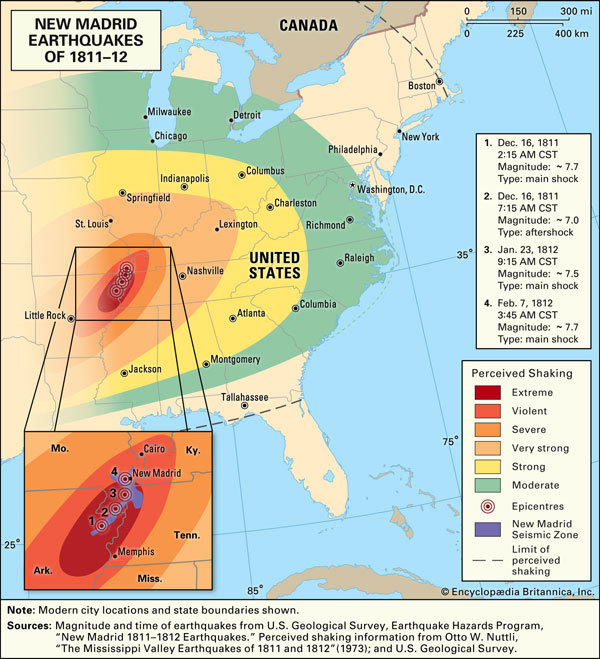 From a scientific standpoint the shock of December 16, 1811, was the worst in American history and one of the greatest on record. Only the fact that the district affected was thinly settled and that most of the structures were cabins and huts well adapted to resist quake damage prevented a tremendous loss of the life and property.
From a scientific standpoint the shock of December 16, 1811, was the worst in American history and one of the greatest on record. Only the fact that the district affected was thinly settled and that most of the structures were cabins and huts well adapted to resist quake damage prevented a tremendous loss of the life and property.
The New Madrid earthquake occurred before word of the Battle of Tippecanoe could reach the Creeks and Cherokees in the south, but they remembered the words of Tecumseh. Writes R.E. Banta:
The earth in the Mississippi and lower Ohio valley did shake—such shaking as was unknown to Indian tradition—the sky was darkened, and the sun glowed faintly red through those thick clouds of dust. Immediately, by report, the southern Indians seized their weapons and started north—if this was a sample of Tecumseh’s stamping, they probably reasoned, ’twere as well to make a propitiating gesture. Before they had gone far they learned that it was too late.
On May 15, 1812, in what is now the pasture of a farm near Peru, Indiana, Tecumseh built the fire for the last great council of the woodland chiefs—his final attempt to organize the tribes of the middle west into a confederation. With tears in his eyes he raised his arms and said: “Our fathers, from their tombs, reproach us as slaves and cowards. I hear their voices now in the wailing of the winds . . .”
But the defeat of Tippecanoe was still fresh in the minds of the assembled warriors. Despite Tecumseh’s eloquence, the chiefs arose and stated firmly that they were done with strife. The whites were too numerous, too strong. Their British friends were too far away. And Tecumseh, realizing that his power had waned, slowly and sadly extinguished his last council fire. With its dying embers faded his dream.
Tecumseh returned to Ontario and Fort Malden. Now the remains of the confederacy merged with the greater struggle between Great Britain and the United States—the War of 1812. The surrender of Detroit and the Michigan Territory in August 1812 gave the British control of the Great Lakes region, but a year later the tide of war had changed.
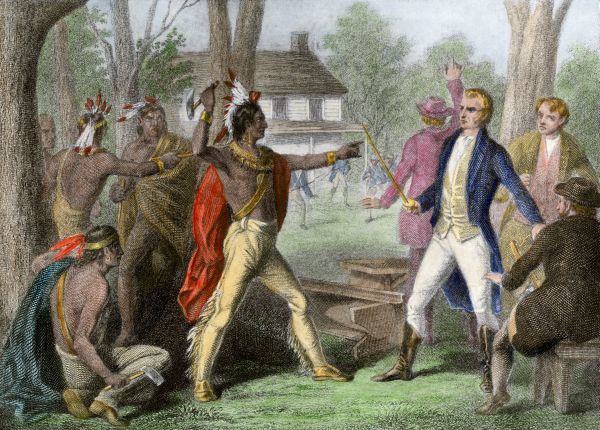 By a curious twist of fate General Harrison was placed in command of the American forces that far outnumbered the troops under General Procter and the Indians under Tecumseh. From Fort Meigs, above Toledo, Harrison pursued the retreating British into Canada. On October 4, 1813, the Battle of the Thames was fought. The outcome was a foregone conclusion. For the final time Tecumseh and Harrison met, enemies to the last. The Amerinds fought desperately until Tecumseh fell, a bullet lodged in his heart. His fellow warriors buried his body in an unmarked grave.
By a curious twist of fate General Harrison was placed in command of the American forces that far outnumbered the troops under General Procter and the Indians under Tecumseh. From Fort Meigs, above Toledo, Harrison pursued the retreating British into Canada. On October 4, 1813, the Battle of the Thames was fought. The outcome was a foregone conclusion. For the final time Tecumseh and Harrison met, enemies to the last. The Amerinds fought desperately until Tecumseh fell, a bullet lodged in his heart. His fellow warriors buried his body in an unmarked grave.
The Prophet lived in Canada on a pension from the British government until 1826, when he returned to the United States. George Catlin, famed ethnologist and artist, painted his portrait in 1832 (image above). This painting is on exhibit at the National Museum of Natural History at Washington, D.C.
As for General Harrison, he entered the White House in 1840 on the campaign slogan of “Tippecanoe and Tyler Too!” And that is when the as it was called curse of Tippecanoe began. The curse is said to have been instituted by the Prophet about the time of Harrison’s election. Harrison caught a cold on his inauguration day and died a month later from pneumonia.
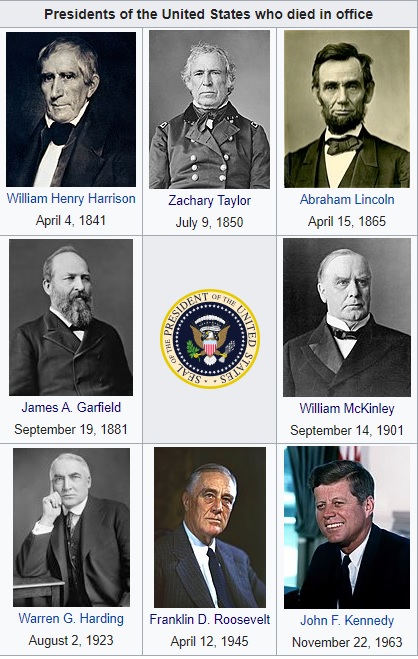 So began the presidential death cycle. Since that time every president elected at a twenty-year interval has died in office. An estimate of the odds of this against chance must at least be thousands to one. President Lincoln was elected in 1860 and was assassinated five years later; President Garfield, elected in 1880, was assassinated in 1881; President McKinley, reelected in 1900, was assassinated in 1901; President Harding, elected in 1920, died in 1923; President Roosevelt, reelected in 1940, died in 1945; and President Kennedy, elected in 1960, was assassinated in 1963.
So began the presidential death cycle. Since that time every president elected at a twenty-year interval has died in office. An estimate of the odds of this against chance must at least be thousands to one. President Lincoln was elected in 1860 and was assassinated five years later; President Garfield, elected in 1880, was assassinated in 1881; President McKinley, reelected in 1900, was assassinated in 1901; President Harding, elected in 1920, died in 1923; President Roosevelt, reelected in 1940, died in 1945; and President Kennedy, elected in 1960, was assassinated in 1963.
John Kennedy had been warned of this death cycle while a candidate for presidency. Whenever the matter was brought up, his reply was that if every candidate took such a warning seriously, there would be no one willing to serve as president. The curse is alleged to have been communicate to John Tyler, who succeeded Harrison as president.
Soon after the assassination of President Kennedy, L. Taylor Hansen, the expert on Amerind history and lore, sought out a sachem or wise man, and the story of the visit is told in Search magazine. “There are some very good ones left,” the writer says, “among the Sioux, the Apache, the Navajo and other tribes to name a few.” The visitor wanted to know why an innocent man had been stricken in a curse which took place over a small battle so very long ago?
The wise man explained that the battle took place in 1811, but the curse pronounced by Tens-Ka-Ta-Wah, or the Prophet, was made around 1840. It was not so much concerned with the battle as with the treatment of the Indian people, for it was around the 1830s that the various trails of tears took place.
Under a law enacted in 1830 all tribes east of the Mississippi were to cede their lands in exchange for territory in the west. The Choctaw led the exodus during the winters of 1831 to 1834 in pathetic bands of 500 to 1,000. Three years later, the Chickasaw joined them. Then came the Creeks, with their chiefs in chains. Of the 15,000 Creeks driven west, 3,500 died of disease and exposure. The great Cherokee migration began in the spring of 1838. They suffered “indescribable hardships,” as the American Heritage Book of Indians puts it, from which 4,000 of the 13,000 emigrants perished. In 1838 it was the Potawatomi and the Prophet’s own tribe, the Shawnee, that were moved west into Kansas and what is now Oklahoma.
Prodded along by U.S. Soldiers, they were allowed to take only what they could carry on their backs. Many left comfortable homes and rich farms with cattle behind. There were outbreaks of malaria and other diseases, and the trails were littered with the dead and dying, but the marches kept on and on to Indian territory. No one was allowed to stop to care for the sick.
“In that horror,” said the sachem, “was born the curse for the man who sought the presidency that year with the unforgotten slogan ‘Tippecanoe and Tyler Too.’ He was the focal point for the agony and fury of a despairing and defeated people.”
“But why has the curse continued to this day?” inquired Hansen.
“Because of continued mistreatment down through the years. Massacres like those at Sand Creek and Wounded Knee. Perhaps the curse spectre gains his strength from greed, broken promises.”
“What would The Lord of Wind and Water say to curses?” asked Hansen.
“What would Jesus Christ say to broken promises and horrors like the trails of tears? There are good men and bad men among my people, as there are among the whites. Also there are those among my people who have strange power—as you know. Not all of them are good. But I hope, as I know that you do, that in time the curse of Tippecanoe will have nothing to feed on, and the power of the spectre will fade away to nothing.”
Excerpt from American Indian Myths & Mysteries
Posted in Other Topics, True History of Manwith comments disabled.


